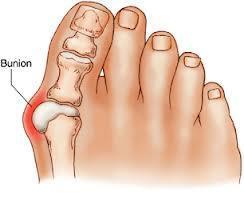5 Tips for Soothing Bunion Pain
5 Tips for Soothing Bunion Pain

A bunion is a bone and soft tissue deformity of the foot that can cause constant or relapsing pain and inflammation. The term bunion means bump, which describes its characteristic appearance on the big or little toe side of the foot, at the base of the toe.
The number one complaint a bunion sufferer has is pain and irritation. The pain is caused by inflammation that is occurring around the tissues of the toe joint, which are being progressively stretched as the bones shift out of position.
A bunion may also rub against a tight shoe, creating further irritation.
As with any foot pain, it is best to seek medical care. In addition, here are some tips that can help reduce bunion pain:
Start with a soak. A cool foot soak is an easy way to soothe sore, irritated feet. If you don’t have a foot spa at home, any clean basin will do. Pour a few tablespoons of Epsom salt or your favorite bath salts into the basin and fill with cool or lukewarm water, enough to cover the ankles. Epsom salt can easily be found anywhere first aid supplies are sold. Soak anywhere from 5 to 15 minutes.
Stretch your toe. Stretching exercises are a great way to address sore joints – and this includes toes, too. While seated comfortably, use a strap (or your hands if you’re flexible) to grasp your toe. Gently pull the toe through a comfortable range of motion. Hold for 30 seconds and repeat a few more times. Try gently stretching the toe away from the next toe, also holding for 30 seconds and repeating. For example, if you have a bunion on the big toe side, grasp your big toe and stretch it away from the second toe. Discontinue any stretching if pain worsens.
Apply a topical analgesic. There are a variety of topical pain relief gels and creams available at stores and online. Many of these products contain menthol or similar ingredients that cause a cooling sensation. Some products contain capsaicin, a compound derived from chili peppers that temporarily blocks pain signals to areas where it is applied. One popular product with capsaicin is Zostrix (compare prices).
Try a bunion relief splint or toe spacer. There are a few different bunion relief devices that can help reduce pain and inflammation, mainly by reducing stress on the toe joint (metatarsophalangeal joint). See 5 Products for Bunions for more information about these products and links to compare online prices.
Try new shoes. Having your feet sized isn’t just for kids. Our feet may change in size throughout our lives and it’s a good idea to measure your feet – not just for length, but width as well. A bunion usually leads to a gradual widening of the forefoot, unfortunately requiring a wider size shoe for comfort. When you think of dress shoes for bunion feet, you may picture those old-style orthopedic shoes – but rest assured, there are many more fashionable styles to choose from. Try searching large online stores, such as Zappos.com, to see an array of wider sizes. There are also a variety of styles of athletic shoes that are ideal for feet with bunions. If you have a favorite pair of shoes that are too tight over your bunion, you can also have that area stretched at a shoe repair or leather repair store. If you find that wider shoes provide comfort in the forefoot area where the bunion is but are too wide in the heel area, try adding a 3⁄4 length arch support to your shoe to improve fit.
By Catherine Moyer For Very Well
Be the first to post a message!